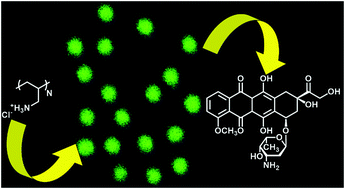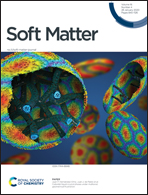A study of the complex interaction between poly allylamine hydrochloride and negatively charged poly(N-isopropylacrylamide-co-methacrylic acid) microgels†
Abstract
Negatively charged poly(N-isopropylacrylamide-co-methacrylic acid) (P(NIPAm-co-MAA)) microgels undergo size changes in response to changes in temperature and pH. Complexation of these microgels with positively charged polyelectrolytes can greatly affect their physical properties and their capacity for encapsulating active molecules. Here we study the interaction between (P(NIPAm-co-MAA)) microgels and a model positively charged polyelectrolyte, poly allylamine hydrochloride (PAH), with different molecular weights. Experiments were conducted at temperatures below and above the lower critical solution temperature (LCST) of the microgel (30–32 °C), at 20 and 40 °C, respectively, and for PAH at molecular weights of 15, 50, and 140 kDa. Below the LCST, dynamic light scattering and zeta potential measurements with molecular simulation show that for the 15 kDa PAH there is preferential accumulation of PAH inside the microgel, whereas for the higher molecular weight PAH, the polyelectrolyte deposits mainly on the microgel surface. Above the LCST, PAH is preferentially located on the surface of the microgels for all molecular weights studied as a result of charge segregation in the hydrogels. Confocal scanning laser microscopy and flow cytometry were used to quantify rhodamine labelled PAH associated with the microgel. Isothermal titration calorimetry studies give insight into the thermodynamics of the interaction of PAH with the hydrogels, and how this interaction is affected by the molecular weight of PAH. Finally, microgels with encapsulated doxorubicin were exposed to PAH, revealing that the drug is displaced from the microgel by the PAH chains.



 Please wait while we load your content...
Please wait while we load your content...